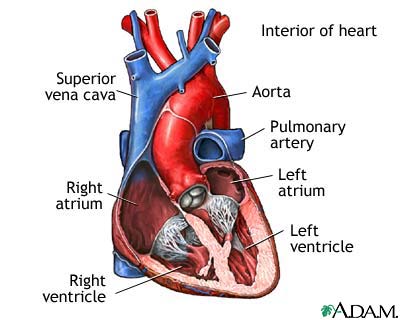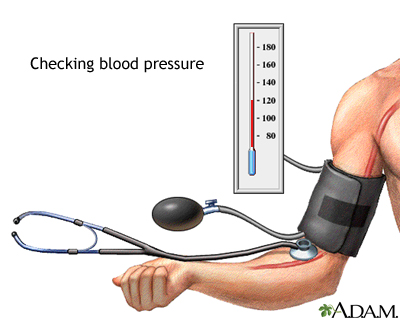Aging Changes in The Heart and Blood Vessels
Taking your carotid pulse

The carotid arteries take oxygenated blood from the heart to the brain. The pulse from the carotids may be felt on either side of the front of the neck just below the angle of the jaw. This rhythmic "beat" is caused by varying volumes of blood being pushed out of the heart toward the extremities.
Circulation of blood through the heart

The heart is a large muscular organ which constantly pushes oxygen-rich blood to the brain and extremities and transports oxygen-poor blood from the brain and extremities to the lungs to gain oxygen. Blood comes into the right atrium from the body, moves into the right ventricle and is pushed into the pulmonary arteries in the lungs. After picking up oxygen, the blood travels back to the heart through the pulmonary veins into the left atrium, to the left ventricle and out to the body's tissues through the aorta.
Radial pulse

Arteries carry oxygenated blood away from the heart to the tissues of the body; veins carry blood depleted of oxygen from the same tissues back to the heart. The arteries are the vessels with the "pulse", a rhythmic pushing of the blood in the heart followed by a refilling of the heart chamber. To determine heart rate, one feels the beats at a pulse point like the inside of the wrist for 10 seconds, and multiplies this numbers by six. This is the per-minute total.
Normal heart anatomy (cut section)

The normal heart viewed so that major valves can be seen.
Effects of age on blood pressure

Blood vessels become less elastic with age. The "average" blood pressure increases from 120/70 to 150/90 and may persist slightly high even if treated. The blood vessels respond more slowly to a change in body position.
Information
Some changes in the heart and blood vessels normally occur with age, but many others are modifiable factors that, if not treated, can lead to heart disease.
BACKGROUND
The heart has two sides. The right side pumps blood to the lungs to receive oxygen and get rid of carbon dioxide. The left side pumps oxygen-rich blood to the body.
Blood flows out of the heart through arteries, which branch out and get smaller and smaller as they go into the tissues. In the tissues, they become tiny capillaries.
Capillaries are where the blood gives up oxygen and nutrients to the tissues, and receives carbon dioxide and wastes back from the tissues. Then, the vessels begin to collect together into larger and larger veins, which return blood to the heart.
Aging causes changes in the heart and in the blood vessels. Heart and blood vessel diseases are some of the most common disorders in the elderly.
AGING CHANGES
Heart
- Normal changes in the heart include deposits of the "aging pigment," lipofuscin. The heart muscle cells degenerate slightly. The valves inside the heart, which control the direction of blood flow, thicken and become stiffer. A heart murmur caused by valve stiffness is fairly common in the elderly.
- The heart has a natural pacemaker system that controls heartbeat. Some of the pathways of this system may develop fibrous tissue and fat deposits. The natural pacemaker (the SA node) loses some of its cells. These changes may result in a slightly slower heart rate.
- Heart changes cause the ECG of a normal, healthy aged person to be slightly different than the ECG of a healthy younger adult. Abnormal rhythms (arrhythmias) such as atrial fibrillation are common in older people, which may be caused by heart disease.
- A slight increase in the size of the heart, especially the left ventricle, is not uncommon. The heart wall thickens, so the amount of blood that the chamber can hold may actually decrease despite the increased overall heart size. The heart may fill more slowly.
Blood vessels
- The main artery from the heart (aorta) becomes thicker, stiffer, and less flexible. This is probably related to changes in the connective tissue of the blood vessel wall. This makes the blood pressure higher and makes the heart work harder, which may lead to hypertrophy (thickening of the heart muscle). The other arteries also thicken and stiffen. In general, most elderly people experience a moderate increase in blood pressure.
- Receptors, called baroreceptors, monitor the blood pressure and make changes to help maintain a fairly constant blood pressure when a person changes positions or activities. The baroreceptors become less sensitive with aging. This may explain the relatively common finding of orthostatic hypotension, a condition in which the blood pressure falls when a person goes from lying or sitting to standing, resulting in dizziness.
- The wall of the capillaries thickens slightly. This may cause a slightly slower rate of exchange of nutrients and wastes.
Blood
- The blood itself changes slightly with age. Aging causes a normal reduction in total body water. As part of this, there is less fluid in the bloodstream, so blood volume decreases.
- The number of red blood cells (and correspondingly, the hemoglobin and hematocrit levels) are reduced. This contributes to fatigue. Most of the white blood cells stay at the same levels, although certain white blood cells important to immunity (lymphocytes) decrease in number and ability to fight off bacteria. This reduces the ability to resist infection.
EFFECT OF CHANGES
Under normal circumstances, the heart continues to adequately supply all parts of the body. However, an aging heart may be slightly less able to tolerate increased workloads, because changes reduce this extra pumping ability (reserve heart function).
Some of the things that can increase heart workload include illness, infections, emotional stress, injuries, extreme physical exertion, and certain medications.
COMMON PROBLEMS
- Heart and blood vessel diseases are fairly common in older people. Common disorders include high blood pressure and orthostatic hypotension.
- Arteriosclerosis (hardening of the arteries) is very common. Fatty plaque deposits inside the blood vessels cause it to narrow and can totally block blood vessels.
- Coronary artery disease is fairly common.
- Angina (chest pain caused by temporarily reduced blood flow to the heart muscle), shortness of breath with exertion and heart attack can result from coronary artery disease.
- Abnormal heart rhythms (arrhythmias) of various types can occur.
- Heart failure is also very common in the elderly. In people older than 75, heart failure occurs 10 times more often than in younger adults.
- Valve diseases are fairly common. Aortic stenosis, or narrowing of the aortic valve, is the most common valve disease in the elderly.
- Anemia may occur, possibly related to malnutrition, chronic infections, blood loss from the gastrointestinal tract, or as a complication of other diseases or medications.
- Transient ischemic attacks (TIA) or strokes can occur if blood flow to the brain is disrupted.
Other problems with the heart and blood vessels include the following:
- Peripheral vascular disease, resulting in claudication (intermittent pain in the legs with walking)
- Varicose veins
- Blood clots
PREVENTION
You can help your circulatory system (heart and blood vessels). Heart disease risk factors that you have some control over include high blood pressure, cholesterol levels, diabetes, obesity, and smoking.
- Eat a heart-healthy diet with reduced amounts of saturated fat and cholesterol, and control your weight. Follow your health care provider's recommendations for treatment of high blood pressure, high cholesterol or diabetes. Minimize or stop smoking.
- Moderate exercise is one of the best things you can do to keep your heart, and the rest of your body, healthy. Consult with your health care provider before beginning a new exercise program. Exercise moderately and within your capabilities, but do it regularly.
- People who exercise usually have less body fat and smoke less than people who do not exercise. They also tend to have fewer blood pressure problems and less heart disease.
- Exercise may help prevent obesity and helps people with diabetes control their blood sugar.
- Exercise may help you maintain your maximum abilities as much as possible and reduces stress.
No comments:
Post a Comment